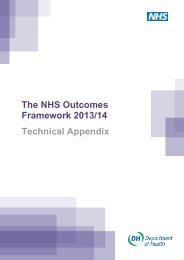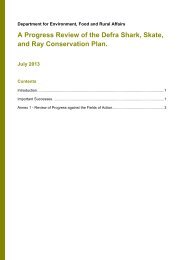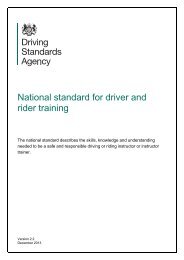Decontamination in primary care dental practices - Gov.uk
Decontamination in primary care dental practices - Gov.uk
Decontamination in primary care dental practices - Gov.uk
You also want an ePaper? Increase the reach of your titles
YUMPU automatically turns print PDFs into web optimized ePapers that Google loves.
<strong>Decontam<strong>in</strong>ation</strong>: Health Technical Memorandum 01-05 – <strong>Decontam<strong>in</strong>ation</strong> <strong>in</strong> <strong>primary</strong> <strong>care</strong> <strong>dental</strong> <strong>practices</strong> (2013 edition)19.55 Calorifiers (where fitted) should be subjected toregular procedures that <strong>in</strong>clude the follow<strong>in</strong>g:• clean<strong>in</strong>g and ma<strong>in</strong>tenance;• quarterly dra<strong>in</strong><strong>in</strong>g to m<strong>in</strong>imise theaccumulation of sludge. This may be extendedto annual dra<strong>in</strong><strong>in</strong>g if, dur<strong>in</strong>g <strong>in</strong>spection, it isfound that there is little accumulation ofdebris;• whenever dismantled for statutory <strong>in</strong>spection,or every year <strong>in</strong> the case of <strong>in</strong>direct calorifiers,calorifiers should be thoroughly cleaned toremove sludge, loose debris and scale;• whenever a calorifier is taken out of service, itshould be refilled, dra<strong>in</strong>ed, refilled aga<strong>in</strong> andthe entire contents brought up to, and held at,the nom<strong>in</strong>al operat<strong>in</strong>g temperature of 60oC forat least an hour.See also Health Technical Memorandum 04-01Part B paragraphs 7.74–7.76 for further advice oncalorifiers.Instantaneous water heaters for s<strong>in</strong>gle or multipo<strong>in</strong>toutlets19.56 The general pr<strong>in</strong>ciples and limitations of<strong>in</strong>stantaneous water heaters are given <strong>in</strong> therelevant parts of BS EN 806-2:2005, BS EN 806-3:2006 and BS 8558:2011. In essence:• the flow rate is limited and is dependent uponthe heater’s hot water power rat<strong>in</strong>g;• where restricted rates of delivery are acceptable,the heater can deliver cont<strong>in</strong>uous hot waterwithout requir<strong>in</strong>g time to reheat;• they are susceptible to scale formation <strong>in</strong> hardwater areas, where they will require frequentma<strong>in</strong>tenance;• this form of hot water heat<strong>in</strong>g should only beconsidered for smaller premises or where it isnot economically viable to run hot waterdistribution to a remote outlet.Safe hot water delivery devices19.57 Appropriate types of thermostatic mix<strong>in</strong>g deviceare specified <strong>in</strong> Health Technical Memorandum04-01 Part A Table 4.19.58 It is essential to check the temperature sett<strong>in</strong>gsand operation of all water mix<strong>in</strong>g devices regularly(preferably every six months, provided that there isno “drift” <strong>in</strong> excess of 1oC). Other ma<strong>in</strong>tenanceshould be strictly <strong>in</strong> accordance with themanufacturer’s <strong>in</strong>structions.19.59 Local water quality will <strong>in</strong>fluence the ma<strong>in</strong>tenancefrequency for any <strong>in</strong>stallation. (A relatively smallpiece of debris may restrict the operation of thetemperature control and fail-safe mechanisms.)19.60 The recommendations regard<strong>in</strong>g safe watertemperature apply to all areas to which patientsand visitors have free access.Materials of construction19.61 Systems should comply with the requirements ofthe Water Supply (Water Fitt<strong>in</strong>gs) Regulations1999. Materials used <strong>in</strong> contact with water that isfor dr<strong>in</strong>k<strong>in</strong>g etc should comply with BS 6920-1:2000 and be listed <strong>in</strong> the latest edition of the‘Water Fitt<strong>in</strong>gs and Materials Directory’ publishedby WRAS.Temperature control regimen19.62 Temperature control regimen is the preferredstrategy to ma<strong>in</strong>ta<strong>in</strong> systems free from Legionellaand other water-borne organisms. This will requiremonitor<strong>in</strong>g on a regular basis. The test frequenciesare listed below <strong>in</strong> Table 1.Po<strong>in</strong>t-of-use filtration19.63 Po<strong>in</strong>t-of-use filters must be changed <strong>in</strong> accordancewith manufacturers’ recommendations, typicallyat least once a month. When chang<strong>in</strong>g filters, it isrecommended that water-quality sampl<strong>in</strong>g takesplace at outlets identified as sent<strong>in</strong>el po<strong>in</strong>ts beforerefitt<strong>in</strong>g a replacement filter. Except where tak<strong>in</strong>gsamples as above, once po<strong>in</strong>t-of-use filtration hasbeen <strong>in</strong>troduced, taps or showers must not be usedwithout a filter <strong>in</strong> place.19.64 Where po<strong>in</strong>t-of-use filters are no longer required,the outlet and associated pipework must bedis<strong>in</strong>fected to remove any accumulated biofilmbefore the system is returned to service (see alsoHealth Technical Memorandum 04-01 Part Aparagraph 5.16).Summary checklist19.65 A summary checklist for hot and cold waterservices show<strong>in</strong>g recommended frequency ofactivity is given <strong>in</strong> Table 2.The checks/tasks outl<strong>in</strong>ed <strong>in</strong> Tables 1 and 2 could becarried out by tra<strong>in</strong>ed user or contracted-out to a thirdparty.72
















